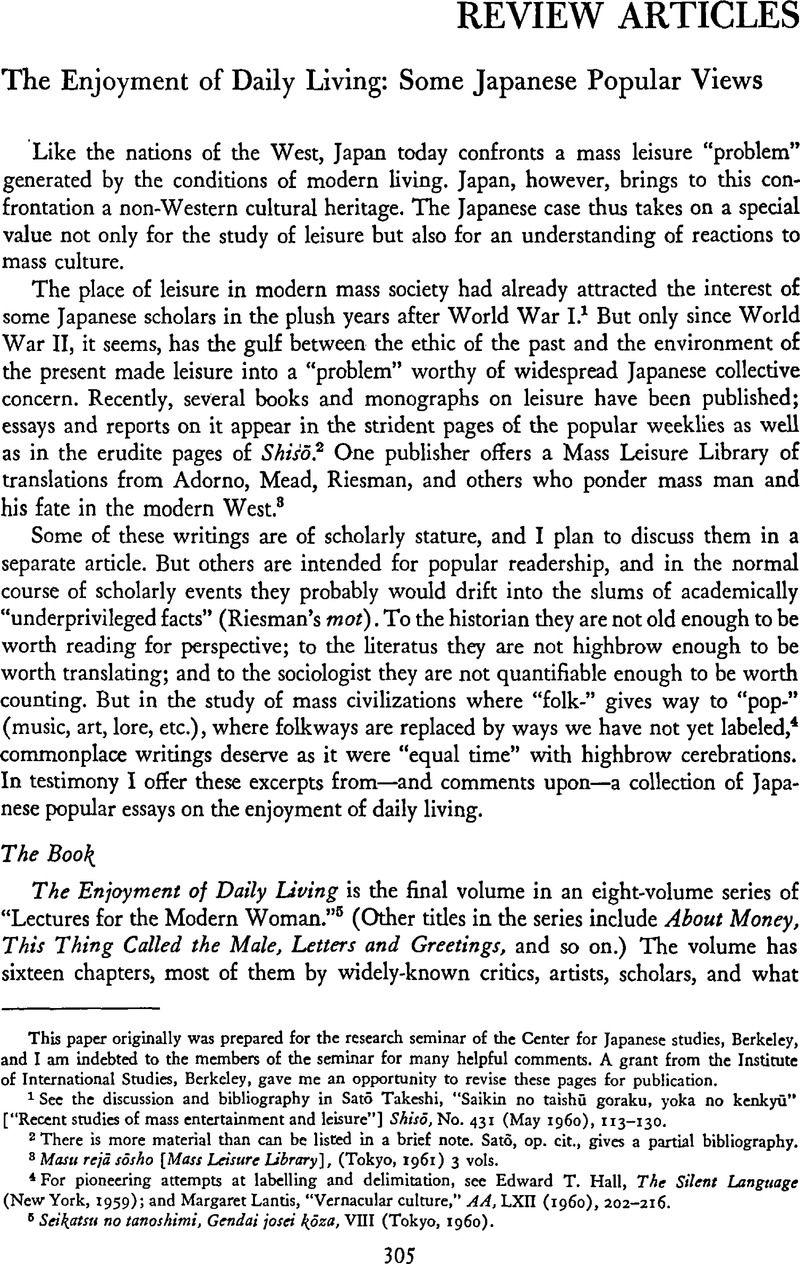No CrossRef data available.
Published online by Cambridge University Press: 23 March 2011

1 See the discussion and bibliography in Satō Takeshi, “Saikin no taishū goraku, yoka no kenkyū”
[“Recent studies of mass entertainment and leisure”] Shisō, No. 431 (05 1960), 113–130.Google Scholar
2 There is more material than can be listed in a brief note. Satō, op. cit., gives a partial bibliography.
3 Masu rejā sōsho [Mass Leisure Library], (Tokyo, 1961) 3 vols.Google Scholar
4 For pioneering attempts at labelling and delimitation, see Hall, Edward T., The Silent Language (New York, 1959)Google Scholar; and Lantis, Margaret, “Vernacular culture,” AA, LXII (1960), 202–216.Google Scholar
5 Seikatsu no tanoshimi, Gendai josei kōza, VIII (Tokyo, 1960).Google Scholar
6 By rough tabulation I counted 420-odd different English loan-words in the text. In a few instances I may have counted repeated uses of the same word more than once, but I omitted all proper nouns (Chicago, Babe Ruth, Chaplin, etc.). I counted as one such unusual usages as shiizun ofu [“off season”]. And I omitted as unclassifiable a few curiosities such as chippu noirōze [“tip neurosis” i.e., the headaches of tipping serving-persons].
7 Shin'gorō, Takaishi, “Introduction,” Women and Wisdom of Japan, (London, 1914), p. 11.Google Scholar
8 On the deep-seated psychological meaning of self-sacrifice among the Japanese, see De Vos, George, “The Relation of Guilt Toward Parents to Achievement and Arranged Marriage Among the Japanese,” Psychiatry, XXIII (08 1960), 287–301.CrossRefGoogle Scholar
9 Benedict, Ruth, The Chrysanthemum and the Sword (Boston, 1946), p. 192.Google Scholar
10 Ibid., p. 192.
11 Takaishi, , op. cit., p. 19.Google Scholar
12 Cf. De Vos: “The sometimes inexplicable—to Western eyes at least—logic of the self-immolation practised in wartime by the Japanese soldier can better be explained when seen as an act of sacrifice not resulting only from pressures of group morale and propaganda stressing the honor of such a death. The emotions that make such behavior seem logical are first experienced when the child observes the mother's attitude toward her own body as she often exhausts it in the service of the family.” Op. cit., p. 291.
13 Baber, Ray E., Youth Looks at Marriage and the Family, a Study of Changing Japanese Attitudes, (Tokyo, 1958), pp. 24–29.Google Scholar
14 Larrabee, Eric and Meyersohn, Rolf, Mass Leisure (Glencoe, Illinois, 1958)Google Scholar especially the article by Wolfenstein, Martha, “The Emergence of Fun Morality,” pp. 86–96Google Scholar. See also the special issue on “Sociological Aspects of Leisure.” international Social Science Journal XII, 4 (1960).Google Scholar
15 Takeshi, Ishida, “Popular Attitudes Toward the Japanese Emperor,” Asian Survey, II, 2 (04, 1962), 29–39.Google Scholar
16 Vogel, Ezra F., “The Democratization of Family Relations in Japanese Urban Society,” Aston Survey, I, 4 (06, 1961) 18–24.CrossRefGoogle Scholar
17 The phrase is from a thoughtful paper by Hallowell, A. Irving, “The Self and its Behavioural Environment,” Explorations, II (04, 1954)Google Scholar; reprinted as Ch. IV in his Culture and Experience, (Philadelphia, 1955).Google Scholar
18 See the excellent review by Bronfenbrenner, Martin, “Some Lessons of Japan's Economic Development, 1853–1938,” Pacific Affairs, XXXIV (Spring, 1961) 7–27.CrossRefGoogle Scholar
19 Reisman, David, The Oral Tradition, the Written Word, and the Screen image, Antioch College Founders Day Lecture (Yellow Springs, Ohio, 1955).Google Scholar
20 For example on the Tokugawa city, see Smith, Robert J., “Pre-industrial Urbanism in Japan: a Consideration of Multiple Traditions in a Feudal Society,” Economic Development and Cultural Change IX, 1 part 2 (10, 1960) 241–257Google Scholar. On the Tokugawa village, Smith, Thomas C., The Agrarian Origins of Modern Japan (Stanford, California, 1959)Google Scholar, passim.
21 Riesman, , op. cit., p. 36.Google Scholar
22 Nyōzekan, Hasegawa, Ushinawareta Nihon [The Lost Japan] 1952Google Scholar, as translated in part in Tsunoda, de Bary, and Keene, Sources of the Japanese Tradition, (New York, 1958) pp. 819–900Google Scholar. Quotation from page 893.